



Quantification of Right Ventricular Function in Pulmonary Hypertension using Cardiac PET Images Simisani Takobana M.A.Sc Defense Department of Systems and Computer Engineering Carleton University Supervisors: Dr. Ran Klein, University of Ottawa Heart Institute Dr. Andy Adler, Carleton University
Motivation and Goals Motivation: 3 year survival 48% without treatment and 55% with current therapy. Long term goal: To understand the risk factors and causes of pulmonary hypertension (PH), understand disease progression, and develop therapies. Immediate goal: Develop an automatic tool with optional operator intervention for defining RV region of interest in 3D cardiac images: ◦ Used to quantify RV cardiac function. ◦ Used to quantify RV molecular function. http://www-sop.inria.fr/asclepios/projects/Health-e- Child/DiseaseModels/content/cardiac/tofSimu1_intr oduction.php Hypertrophic RV Normal RV
Introduction – Literature Review Advanced PH is associated with RV hypertrophy and dysfunction. 1,2 Previous work investigated use of SPECT for imaging advanced disease. 1,2,4 ◦ Limited understanding of PH and its relation to RV function. ◦ Manual segmentation of the RV. Early RV disease may be better detected and understood with SPECT and PET imaging. 1 ◦ Perfusion? ◦ Metabolism? Automatic quantification of left ventricular (LV) function using FlowQuant. 3 ◦ RV function not currently measured for PET images. [1] Pereira, JNM 1997:38(2);254. [2] Naeije, European Heart Journal Supplements , vol. 9, no. suppl H, p. H5, 2007 [3] Klein, Nuclear Science Symposium Conference Record, 2006. [4 ] Mannting, JNM, vol. 40, no. 6, pp. 889 – 894, Jun. 1999.
Brief Overview of PET and SPECT Injected tracer – trace amounts of specific molecule that interacts physiologically. Specialized camera detect radiation and reconstruct 3D image volume of tracer concentrations.
Introduction – Model properties Automatically register RV ROI with optional operator intervention: ◦ Accommodate all RV anatomies (normal, hypertrophic) ◦ Minimum control points and degrees of freedom Non-PH human PH human PH rat RV LV LV RV RV LV Horizontal Long Axis (HLA) Short Axis (SA)
Defining Model Shape ◦ 12 control points (13 degrees of freedom). Initially estimated based on LV shape. Automatically optimized Adjustable by operator (GUI)
Defining Model Shape - Interpolation RVLA LVLA RVLA LVLA RV LA LV RV LV LA z C. Hypertrophic RV D. Morphed Hypertrophic RV and LV RV LV Anterior ◦ Sampling points interpolated in pseudo-cylindrical coordinate system: Free Wall 16 slices by18 sectors = 288 sampling points. Radii interpolated for each slice and sector. Posterior
Graphical Representation 3D Mesh Short axis (SA) slices Horizontal Long Axis (HLA) slice Polar Map RV LV
Global Contour Optimization Minimization of a cost function 𝐷 = 𝐷 𝑗𝑜𝑢𝑓𝑜𝑡𝑗𝑢𝑧 + 𝐷 𝑑𝑝𝑜𝑡𝑢𝑠𝑏𝑗𝑜𝑢𝑡 • Maximization of sampled image intensity 𝐽 𝑛𝑏𝑦 𝐷 𝑗𝑜𝑢𝑓𝑜𝑡𝑗𝑢𝑧 = • 𝑞∈𝑆𝑃𝐽 𝐽 𝑛𝑏𝑦 −𝐽 𝑞 where I max is the maximum image intensity and I p is the image intensity of pixel p Constraints on RV shape and size Unlikely anatomy Unlikely anatomy Unlikely anatomy RV LV LV RV Anterior Anterior Free Wall Free Wall Posterior Posterior
Model Validation and Characterization Model Appropriateness ◦ Manual adjustment of control points Automation Performance Operator Dependent Variability ◦ 2 operators x 2 runs each ◦ Tracer uptake reproducibility ◦ Sampling point position variability Cavity Volume and EF Accuracy (PET vs. CMR)
Model Validation-Results Model appropriateness - 20 Images (5 non-PH, 5 PH, 5 normal rat, 5 PH rats*) ◦ 14 passed, 6 failed ◦ Low image intensity in normal rats Automation performance - 14 Images that passed model evaluations: ◦ 7 complete automation ◦ 13 successful automatic fitting of the free wall Passed case Failed case * PH induced by treating with monocrolatine (MCT)
Model Validation - Operator Variability RV LV 2 operators (current) (Klein et-al) ◦ Expert and Novice RPC RPC 2 runs each: Intra Operator Op 1 (expert) 5.6 0.97 ◦ separate days ◦ Variability Op 2 (novice) 6.4 1.2 anonymized ◦ Randomized order Inter Operator Variability 8.2 1.8
Cavity volume and EF accuracy-Results • (PET vs. CMR)
Results Summary Complete automation not achieved due to: ◦ Image Intensity ( low around the atrium) ◦ Spillover from LV ◦ A wide range of RV anatomies ◦ RV bifurcation into PA and RA Nevertheless, semi-automated tool can be used for current research. Trimmed Region Global RV Free wall Proximal Medial Distal
Discussion and Limitations Operator reproducibility ◦ Did not include animal images. ◦ Limited demographics. Cardiac function accuracy (PET vs. CMR) ◦ Small number of patients. ◦ Limited demographics. Only used 18 F labeled tracers. ◦ Lower quality images not included. ◦ Did not include SPECT image.
Conclusions Developed, validated, characterized, and demonstrated a spline model that sufficiently registers the RV region of interest semi-automatically. ◦ First of its kind ◦ Sufficient for current and future research of PH in animal models and clinical studies. Future Work ◦ Improve Automation ◦ More Validation ◦ Development and evaluation of kinetic modeling for quantification of physiologic function.
Acknowledgement • Ran Klein • Andy Adler • Robert deKemp • Stephanie Thorn • Lisa Mielniczuk
End
Recommend
More recommend